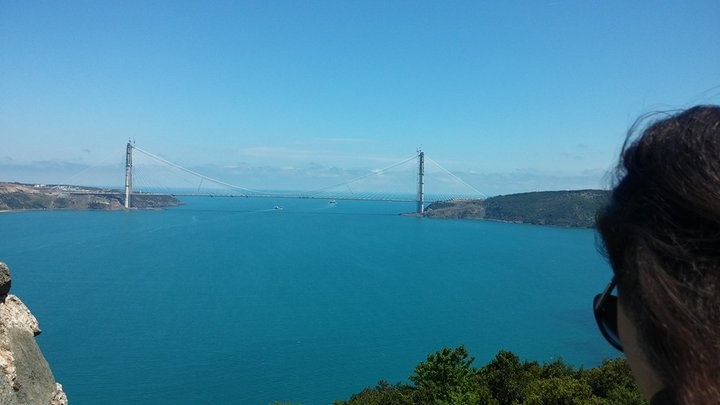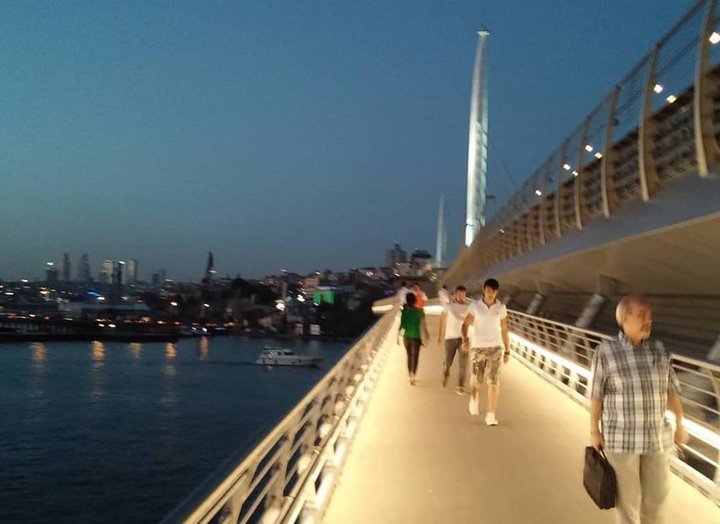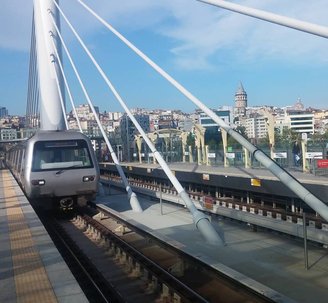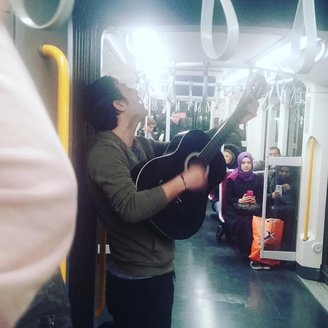
Istanbul
can be a wonderful city in which to wander about – if you are a
tourist and have nothing more pressing than to browse the markets and
think about the lost grandeur of sultans. But if you are someone who
actually lives and works here, who doesn’t have time to regard
former Ottoman splendor, getting around the city has always been, as
one of my British colleagues once elegantly put it, “a bit of a
mind-fuck.”
That’s changing, thank god.
The city celebrated a key milestone this past week. With the completion of the long-anticipated rail line, it is now possible to traverse the entire length of Istanbul and beyond, from the western Halkali district to the outlying district of Gebze in the east – a total distance of nearly 80 kilometers (50 miles) and everywhere in between.
For millions of commuting Istanbullus, not to mention tourists, the city is becoming ever-easier to negotiate. And it feels much more interconnected. As I stood on the platform, watching the train approach, a thought flickered in my head for just a second: why doesn’t America do projects like this anymore? More on that later.
###
For a yabancı like me, the transformation over the past ten years has been startling.
Flying in over the city, you see how vast it truly is, stretching over two continents and spreading out from the Bosphorus into the distance in all directions. On the ground, it can be overwhelming – it certainly was when I first arrived a decade ago. Fortunately, the school sent a driver to pick me up from Ataturk International, so I was spared the shock of having to navigate the public transit system in this city of 15 million souls.
Once I settled in, I began to like the city, the great crowds, the narrow back streets, the bazars flowing with goods, and all the history lurking around every corner. But that didn’t make it easy to get around. There was a metro system, but in those days it was only on the European side, and a few stops at that. If you wanted to go to the Asian side, you had the ferries, or you could take a taxi or dolmuş.
The ferries are picturesque, romantic, but not always expedient. And if the traffic was really bad, as it frequently is, then your taxi or dölmüş could get stuck on the Bosphorus Bridge and take forever. It’s hard to plan anything when you don’t know if the trip will take thirty minutes or two hours.
###

Nowadays,
I live in Üsküdar, on the Asian side. In the morning, I walk down
the hill to the metro. I take the Marmaray under the Bosphorus to
Yenikapı, about a 10-minute journey. Then I transfer to the
airport-bound metro, take two stops at Fatih, where the main campus
of my university is located. All told, the trip from my front door to
the university takes about thirty minutes. And because it’s all
underground, I can count on it being 30 minutes.
Had I taken the same trip a decade ago, I would have had to first take a ferry from Üsküdar over to Kabataş on the European side, then get a tram or bus. Either way, the trip would have taken at least an hour, or with traffic, even longer.
And on the weekend, if my wife and I want to go to Taksim for dinner, we can jump on the metro, make one transfer, and be in the heart of Taksim Square in about twenty minutes. Again, the same journey in the past would have involved the ferry, then a bus and lots of traffic, especially on the weekend.
In big cities, space is at a premium, but so is time. Most people put in twelve, even fourteen-hour days, much of it spent in commute. So anything you can do to shave a half hour here, a half hour there, is gold. It can be the difference between getting home at 8 pm and 9 pm, or even more. It can be the difference between actually having an evening at home with your family versus merely getting home and going straight to bed like some ceaseless, work-bound automaton.
So it not just getting much easier to get around, but to actually plan things for a change.
###

I’ve been quietly wondering if the completion of the new train line will have any noticeable effect on the upcoming mayoral elections. Surely, the timing is telling. For years, the ruling AK Party has gotten proven mileage by such infrastructure projects. Along with the expansion of the subway network, there is also now an under-the-strait tunnel for trucks and cars. Also, the Bosphorus now has three transcontinental bridges.
Say what you will about the country’s president, Recep Tayyip Erdogan. Often criticized in the West for his authoritarian style, the man knows how to get infrastructure projects pushed forward. Maybe it helps that he used to be mayor of Istanbul. Like all big city mayors, Erdogan has always understood that infrastructure – getting around – is one of those issues, like crime, that’s forever close to people’s hearts.
Indeed, this past week Erdogan was reliably present for the opening of the completed new pan-Istanbul train line, even piloting the inaugural train himself, something he has done on previous occasions. Regardless of how his party performs in the elections, the president no doubt will be on hand as well when the newly completed Istanbul International airport opens next month. The new airport, which will replace Ataturk International, is set within the next decade to become the world’s largest airport, serving some 200 million passengers per year.
Turkey’s powerful president has a lot in common with his American counterpart. He longs to restore this region to its historic glory. To make Turkey Great Again. In Erdogan’s eyes, he is doing that.
And in some ways he is – at least here in Istanbul.
Of course, the Turkish voters may not buy it this time, as they have in the past. The economy figures to be the big issue: inflation has risen by some 30 percent over the past year. Voters in the towns and villages, who may well be a lot more interested in the price of vegetables than a spanking new, 1 billion-dollar train that they will most likely never use.
But then again, such voters in the past have long stayed loyal to Erdogan, through a 2013 corruption scandal and a failed military coup just three years ago.
Why?
“(Erdogan) is building things,” these loyalists frequently say. “He is building bridges, highways and airports. The opposition? They have no projects. They are just sitting around complaining.”
To coin a key election question: Will voters decide with their eyes or with their stomachs?
###

As I said, Istanbul’s most recent public transit milestone got me thinking of America. I felt nostalgic. Remember when America used to build these kinds of things? Great public projects, like the Hoover Dam, or the national highway system. Nowadays you read about such ambitious projects, and it seems they’re all over in this part of the world.
And remember back in 2016, when then-presidential hopeful Donald Trump promised to rebuild America’s infrastructure? He talked about building highways, bridges, airports, all part of his Make America Great Again platform.
What happened? To those great projects? To those great promises?
A quick Google search showed that Trump’s reported 1 trillion-dollar infrastructure plan is dead, having failed to get through Congress.
Why? I mean, my wife and I flew to New York a few years ago, we couldn’t help but notice how old and small JFK was. At the same time, the subway ride from the airport to Midtown Manhattan was excruciatingly slow, and the cars dirty, especially when compared with the sleek, brand-new trains in our city, and in other places we’ve traveled.
Seeing such decay through my wife’s eyes was a little embarrassing. I mean, isn’t America supposed to be the center of modernity, of progress? Well, it used to be anyway.
Perhaps if the Trump Administration had put more energy into selling the Infrastructure Plan and less on building an expensive, controversial Wall at the US-Mexico border, they might have had more success. But then again, along with other public projects, Turkey has also managed to complete a border Wall at the Turkey-Syria border. Stretching some 764 kilometers (475 miles), the Wall was completed late last year, mostly in an attempt to stem the tide of refugees and as a security measure against fallout from the ongoing civil war South of Turkey’s border.
My countrymen back home have been wrestling with this Wall issue for some time now. But they have been struggling with many such issues, for some two decades now. A lot of it seems to go back to national focus, or lack thereof.
If you ask me, I’d say the problem with walls (like expensive, foreign wars) is that they don’t tend to work. Ask the Germans about that. And over the long haul they tend to obstruct your vision, a department in which America seems to be sorely lacking nowadays. Forget the Wall: try building trains, bridges, highways, the way you used to, America. You were once great at building such things – and many others – and could be again..
###
James Tressler, a former Lost Coast journalist and resident, is a writer and teacher living in Istanbul.
CLICK TO MANAGE